Panama's Great Sporting Figures
LLOYD LABEACH
He is the only Panamanian athlete who has not just one but two Olympic medals to his credit. It was in the 1948 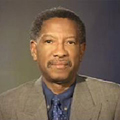 Olympic Games held in London , England , when he finished third in the final 100 and 200-meter dash athletics.
Olympic Games held in London , England , when he finished third in the final 100 and 200-meter dash athletics.
Lloyd was born in 1922 of Jamaican parents who migrated to Panama to work in the Canal construction. He was trained by Coach Carlos Belisario and in 1946 he won a scholarship to study in the University of Wisconsin , where he would continue his training. As the cold weather affected his health, he then moved to the University of California in Los Angeles where his sporting quality improved and finally graduated in 1948.
He was awarded the “Vasco Núñez de Balboa” Order by the Government of Panama for his achievements in London . His scores and results on tracks of various parts of the world gave him world recognition. During the 1951 “Bolivarianos” Games in Guayaquil , Ecuador , he timed 10.1 seconds in the hundred meters, a score that was never recognized by the world's athletics authorities.
After a fruitful life as sprinter, he retired in 1957. By then, he was already married and had children, so he took the decision to settle in Lagos , Nigeria (Africa), where he set himself up in business as an importer and exporter of farm produce, though he later moved to the United States during the early nineties.
The National Sports Institute of Panama, on behalf of the National Government, awarded him the “Manuel Roy” Sports Merit Medal, in recognition of his two bronze Olympic medals, an achievement that no one else in this country has made nearly 60 years later.
ROMMEL FERNANDEZ
He was an excellent football player who died in a car accident on May 6, 1993, when he had just turned 27. This forward player, who was 1.85 meters tall and weighed 81 kg , had begun practising the most universal sports at the age of 4 and quickly made his first achievements at Amador Square children's leagues.
He later joined the Atlético Panamá, Alianza and others who helped him not only in his sports training but also financially. He was such a high-quality athlete that he even got to play in Europe .
Many people remember that during the 2 nd Emigration's World Football Championship held in 1986 in Tenerife, tall and slim Rommel became the sub leader of goal scorers, something unexpected for those who were not fully aware of that forward's talent.
He caused such good impression in that Canary island that was almost immediately hired to play there and after two seasons, where he scored eight and 19 goals, respectively, he was the driving force for the Tenerife team to come up to the First Division. He staid in the line-up until the 1990-1991 games, where he was bought by Valencia CF and later loaned to the Albacete , where he recovered his nose to score goals. It was then that Fate took him away at a time of splendour to the extent that he was considered to be Panama 's most outstanding sportsman. As a well-deserved tribute, the National Football Federation Authorities decided to name the Revolution Stadium after Rommel Fernández.
ROBERTO “STONE HAND” DURÁN
He was of a very humble origin. At the age of 13 he had to quit school to support his family and to do that he had to  face up to countless and badly paid jobs. Professional boxing took him before he turned 17.
face up to countless and badly paid jobs. Professional boxing took him before he turned 17.
His take off in the ring was meteoric as he won victory after victory thanks to his powerful punch. By 1971 he made his debut in New York with a knockout on Benny Huertas in a little more than a minute and later ex world champion Kiroshi Kobuyashi (from Japan) and Ángel “Robinsón” García (from Cuba) also fell by knockout. That is how he had the chance to be face to face with champion Ken Buchanan.
The fight to win the title took place on 26 June 1972 when his rival gave up going out into the ring on the 14 th round.
He was already considered a hero in the land that had been hostile to him during his childhood. This was no surprise to anyone though, because over the six years when he was a light-weight champion he defended his title 12 times and defeated the official contenders for the championship. He also won resounding victories in welterweight until he had the chance to fight the new boxing sensation WBC champion Ray Leonard, who lost unanimously to the Panamanian in their fight in Montreal . However, things were very different nearly five months later when they were face to face again, this time in New Orleans , where Leonard gave an excellent performance.
Other failures awaited him for the following two years until he smashed unbeaten Davey Moore to pieces at Madison Square Garden to proclaim himself WBA super welter champion on the same day of his 32 nd birthday. Five months later, Durán lost the welterweight crown to Hagler. He spent one year and a half without stepping into the ring; then he returned and began to climb up positions until he beat welterweight world champion Iran Barkley in 1988 and won another world championship 17 years after he had won his first title.
That same year, Durán and Leonard were found face to face again with the same results in favour of the U.S. boxer. The passing of time led to inactivity in 1990 and, consequently, he lost his title. Durán returned in 1991 trying to resist the loss of his faculties, but suffered a setback to Pat Lawlor. Several failures and few smiles followed for “Stone Hand” ever since, until in June 1997 he won his last victory to Jorge Castro in a match held in the Panamanian gym that is now named after him.
MARIANO RIVERA
Little more than a decade as closer pitcher par excellence in the Great Leagues, this 6'2 tall and 185-pound right- handed pitcher, born on 29 November 1969 in Panama City , has become one of Panama 's main baseball figures.
handed pitcher, born on 29 November 1969 in Panama City , has become one of Panama 's main baseball figures.
Considered by many as a symbol of professionalism, respect and spirituality, he plays with the New York Yankees and is one of the mainstays of the Big Apple team.
All Star 1997-1999-2000-2001-2002-2004, Babe Ruth Award 1999, Rolaids Relief 1999-2001-2004, as relay runner of the year and Most Valuable of the World Series in 1999, are some of many awards he has won.
He was Saved-Games Champion in 1999-2001-2004 and Completed-Games Champion in 2004 and together with his team he has won five World Series.
He is a very popular sports figure and his followers have named him “Mo”. Mariano has shown extraordinary responsibility at work whenever he has jumped into the box without virtually drying up his tears due to difficult personal situations he has undergone.
At the national level, his fellow country people saw him play with the West Panama team, where he was shortstop and catcher. In 1989 a Yankees talent hunter did not sign him in. However, when Mariano tried his luck later as a pitcher, he immediately began making an interesting career as a professional baseball player. This great baseball figure in what has been rightly called the Big Show will still delight us with many emotional moments, thanks to his effectiveness and nerves of steel.
LAFFIT PINCAY JR.
His excellence is backed up by over 9 500 victories. He is Panama 's sports pride and, particularly, in the horse racing 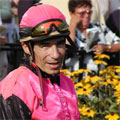 world. Laffit was born on December 29, 1946. He is 5'1 tall and weighs 116 pounds , perfect height and weight for a jockey who has won enviable merits from his first victory on “Smell” on 28 March 1964, but three months later he was already a winner at Clásico Independencia Competition in the United States riding Alucinado II.
world. Laffit was born on December 29, 1946. He is 5'1 tall and weighs 116 pounds , perfect height and weight for a jockey who has won enviable merits from his first victory on “Smell” on 28 March 1964, but three months later he was already a winner at Clásico Independencia Competition in the United States riding Alucinado II.
During his first successful year he won another 64 races, as well as 76 second places and 64 third places.
Over the second season at President Remón Racetrack he joined the exclusive group of jockeys who have achieved more than 200 victories in one year, taking the lead in 249 out of 696 races where he was selected.
It is virtually impossible to detail such a prolific career, but it is fair to say that he has won many awards throughout his professional life, namely, the George Woolf Memorial Jockey Award, the Big Sort of Turfdom Award, the Mike Venezia Award and Melvin Le Roy Racing and Entertainment, amongst others.
He won 42 jockey statistics in seven racetracks in the United States and is the top race winner in the racetrack history in Santa Anita, Hollywood and Del Mar, both in California.
It should be noted that he managed to win over seven races in one day, including six races in a row. Likewise, he won 19 stakes in one season and set a record in one year in Hollywood (148) in Santa Anita (138) and Del Mar (86).
He became the first jockey ever winning 190 million dollars in cash, thus surpassing Billy Shoemaker as the leader in the racetrack history in Santa Anita and Hollywood Park in 1992.
He was included in the Hall of Fame in 1975 after he had won 2 451 races. He won 4 Triple Crown races: Kentucky Derby, once with Swale in 1984; Belmont Stakes for three consecutive years with “Conquistador Cielo” (1982), Caveat (1983) and Swale (1984).
EILEEN MARIE COPARROPA ALEMÁN
She is, probably, one of Panama 's sporting figures who have given most glory to their country, thanks to her fruitful 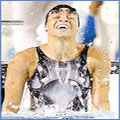 career as a swimmer. From the age of eight years old, when she achieved her first victory in the Dominican Republic , her meteoric rise began, as she was born to break records.
career as a swimmer. From the age of eight years old, when she achieved her first victory in the Dominican Republic , her meteoric rise began, as she was born to break records.
She was called the queen of speed in Central America and the Caribbean, also in South America and the Bolivarian Games. She was the second fastest in the Americas . In 1998, she became the first Panamanian who had ever won two gold medals in Central American and Caribbean Games.
Likewise, she was the first Panamanian undine to win a medal in Pan American Games, specifically in the 50 meter freestyle. Her extensive career is enhanced by more than 600 gold medals won in competitions at various levels in a number of countries.
She has received several honours, including the fact that the old swimming pool “Patria” (Homeland) is honoured to have been named after this “gold mermaid” since 2003. She was awarded the “Manuel Amador Guerrero” Order in the Great Commentator Rank by the National Government.
She has borne Panama 's flag in various regional games, as well as in the Olympic Games in Atlanta ´96, Sydney 2000 and Athens 2004, where she made it to the semifinals in the 50 meter freestyle. From 1996 to 2000, she was consecutively selected as the Female Athlete of the Year and has been involved in several campaigns aimed at fighting scourges eroding the youth, such as drugs and other vices.
JULIO CÉSAR DELY VALDÉS
Panama 's best athlete in the twentieth century. He has been a member of various international football clubs, such as  Argentinos Juniors, Nacional de Montevideo, Cagliari , Paris Saint-Germain. Real Oviedo and Málaga CF.
Argentinos Juniors, Nacional de Montevideo, Cagliari , Paris Saint-Germain. Real Oviedo and Málaga CF.
In 1992, he won Uruguay's football league playing with the “Nacional”, while in the Old Continent he became a key player in the victories achieved by the Paris Saint-Germain during Europe's Cup-winners' Cup and Super Cup, as well as in the Intertoto Cup, with Málaga CF team where he was recorded as the top scorer.
He is one of the top scorers in Panama 's national team. He has participated in the classification stages for the World Cup since 1990 to 2006. He played with Panama 's team in the 2005 Gold Cup where he was runner-up.
After an impressive history as a player, he began to work as a coach in May 2006. Julio made his debut in Panama 's First Division at the age of 15 defending the colours of “Atlético Colón”, but soon that level was too low for his talent.
Therefore, in 1993 he went across the Atlantic to join the Cagliari team, from Italy . After two seasons in Cerdeña, he went for another change of air to fly the flag of the Paris Saint-Germain. He played in 84 official games and scored 29 goals in the two seasons when he defended the colours of the Parisian club, winning one League and a cup-winners' cup in Europe .
At the time when many thought that he was beginning to decline, he played with Oviedo team, from the Spanish League, in 103 games during three years and scored 39 goals. From there, to Málaga team, where he became the highest scorer in the history of that team with 38 goals scored.
Then he joined Montevideo National team where he scored 8 goals in six months, though his fans expected a better performance from this great Panamanian football player of all times who still has a good reputation: he is always spoken of in the present tense.
ISMAEL LAGUNA
He joined the World Boxing Hall of Fame on 10 June 2001 in Canastota , New York , United States . Consequently, 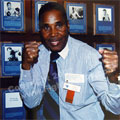 his name became part of a list of a select group of boxers from Panama who have been awarded such distinction.
his name became part of a list of a select group of boxers from Panama who have been awarded such distinction.
He is the youngest world champion who has ever won such an important recognition and therefore is amongst the most outstanding athletes in the history of hired boxing.
At the age of 12, he was a shoeshine boy, sold newspapers and enjoyed to stand up for his younger friends against the older boys. That was his debut as a boxer. He was born on 28 June 1943 and he liked to wander about gyms in Colón city since he was a little boy.
It was on 10 April 1965 when he won the world title as a 135-pound light weight against Puerto Rican Carlos Ortiz. That's how he began his career amongst the best in his division, because Ortiz himself snatched the title from him in a return game later on.
Five years later, Laguna won the title back by a knockout on Armando “Mando” Ramos, but lost it again to Scottish Ken Buchanan nine months later.
He was heartbroken and decided to quit boxing at the age of 28 in September 1971. However, he was privileged to have been world champion on two occasions and, especially, of having received the love, admiration and respect of his people who still values the deeds of this wonderful athlete who honoured his country with his achievements.
DAVIS PERALTA
He played mini-basketball at the age of 12 and five years later, he set a record of 787 scores for a season and 45 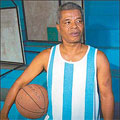 scores for a single game.
scores for a single game.
Even though he is a man of small height, he has extraordinary skills. He soon became the architect of free shots, where he was a leader at the Central American Championship, in Tegucigalpa , Honduras , with an average of 50-43 and a score of 47 in 50 attempts the following year in Guatemala .
With 217 scores in 8 matches, he was best scorer at the 19 th Olympic Games held in Mexico in 1968. By then, this defender, who was born on June 15, 1948, in El Chorrillo town, had achieved the greatest splendor of a fruitful career.
Being 1.78 m tall and after he had participated in countless international basketball competitions and won several awards, including a gold medal at the 6 th Bolivarian Games, Peralta Checa retired in 1978, after he played at the Central American and Caribbean Games held in Medellín, Colombia.
He has always been linked to the sports world and won the affection, respect and admiration of his grateful country where he was born. He had the honour of cutting the ribbon at the opening of Panama 's New Gym on February 12, 1970 (Now “Roberto “Stone Hand” Durán” Gym) and was later Regional Director of the National Sports Institute in David from 1973 to 1975.
He was decorated with “Vasco Núñez de Balboa” Order, INDE, Panama 's Olympic Committee and was presented with the Keys to the City in 1978. He was Director for Sports and Recreation at Municipio de Panamá from 1995 to 1996.
He has held other important positions and has represented Panama 's sports movement in his visits to various countries aimed at seeking new formulas to try and bring basketball back to special levels. This is something that the demanding and knowledgeable local fans have longed for, as they know without doubt that there is sufficient human potential in Panama to carry on with this commitment.
PEDRO “MAGO” RIVAS
This excellent basketball player was born in the province of Colón , rightly considered as the Cradle of Champions in the Republic of Panama . From 1966 onwards, he was an active member of the national basketball team for ten years, a period that is considered by many as the best times of basketball in Panama .
He formed an unbeatable pair with Davis Peralta, and individually, he was selected as part of the all-star teams at several international high-level competitions, including the Americas ' star quintet during the World Championship held in Yugoslavia in 1970. He also had the honour of being part of Panama 's team at the Olympic Games held in Mexico in 1968.
The people in his native land started calling him “Mandrake” and “Mago” (Magician), two names that fitted his flashing offensive performance. However, while he was living in Colón, under the economic conditions that have historically affected that province whose inhabitants are predominantly of an afro Hispanic origin, he had to quit studying to take an offer by the Sporting Cristal team from Uruguay 's basketball league. He felt homesick though, and therefore his stay in the South American country only lasted one season.
During the time he spent in Uruguay , he was baptized as “ Panama 's Basketball Ambassador”. He made such a good impression there, that he was offered to become a citizen of Uruguay , but “El Mago” (The Magician) chose to return to his dear Panama and defend its national colours.
As the once-basketball player said, the remark ever made by the press that urged him the most to write the work “Dos puntos…” “El Mago” Rivas” (Two points… Rivas, The Magician) was a note published by a journalist from Colombia on Rivas' performance at the Olympic Games held in Mexico . He said: “If the future turns Pedro “El Mago” Rivas' performance into mere statistics, that future will be unfair to the history of basketball in Panama and the Americas ”.
Rivas, together with his fellow members of the national team, were the first ones to win a bronze medal for basketball at the Pan American Games and participate in two world championships. As hosts, they won a couple of gold medals, one at the Central American and Caribbean Games and the other, at the Bolivarian games.
CORNELIO VELÁSQUEZ
An outstanding Panamanian horse racing figure, especially in Florida circuit, in Calder and Gulfstream racetracks, he has 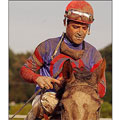 won 1,624 victories.
won 1,624 victories.
On December 13, 1984, only one week after his debut as a horse rider, he won his first race riding Riqui, Riqui and was nominated as the apprentice of the year in 1985, when he broke existing apprentice's records at “Presidente Remón” Racetrack. This record has not been broken ever since.
He won the Classics “Sindicato de Jinetes” (Horse Riders' Trade Union), “José y Antonio Alessandría”, “Sociedad de Dueños de Caballos” (Horse Owners' Club), “Generoso Simona”, “Empleados de Corral”, “Tomás Gabriel Duque y Tomás Gabriel Altamirano Duque”, “República de Perú”, Simeón Allen” and “Felipe Motta”.
During the following seasons, he maintained an impressive rhythm of victories riding various horses. However, he holds the special record as the greatest horse race winner in one day, winning 7 races in one afternoon on June 14, 1987. At “Presidente Remón” Racetrack, he rode 6 234 times, winning 1 624 victories, 1 175 second places, 919 third places, 738 fourth places and 623 fifth places. Over that period, he made nearly six million balboas. He now lives in the United States and some experts say that his best results are still to be achieved.
TEÓFILO “PANAMA AL BROWN”
He was born on July 5, 1902 in Panama , and over a century later his deeds are still remembered, especially the most 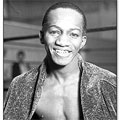 important of all, as he became the first Latin American boxer to win a world championship when he fought for the world bantamweight belt against Vidal Gregorio, of Spain . He beat the Spanish boxer by a decision in 15 rounds at Queensboro Club in a fight settled on June 18, 1929.
important of all, as he became the first Latin American boxer to win a world championship when he fought for the world bantamweight belt against Vidal Gregorio, of Spain . He beat the Spanish boxer by a decision in 15 rounds at Queensboro Club in a fight settled on June 18, 1929.
As the world's champion, he made a total of 11 defences, fighting in the major European cities, until he lost his title on June 1 st , 1935, in Valencia , Spain , to Spanish Baltasar Sangchilli.
“Arena de Colón” Coliseum is honoured to have been named after this legendary boxer who was first known as Kid Teófilo winning the flyweight belt over Salior Patchell. He then migrated to New York , United States , where he lost to this same rival as a result of a fixed decision.
Such disappointment led him to seek refuge in the Paris of his dreams, where he met a sponsor named Jean Costeau. The man of French letters: a poet, a playwright, a novelist, an essayist, took care of him and kept him training until he managed to arrange a new boxing match with Sangchilli.
Brown gave one of the best fights of his life by beating his opponent by a decision, but by that time, Sixto Escobar, the “Black Spider”, had been seated at the throne in America and they refused to acknowledge the Panamanian boxer as a champion, even though he was recognized in the Old Continent.
His significant achievements were handed down to us and became part of the records, because in nearly six years holding the title he had no less than 11 defences. In his entire career, he fought 156 times, 58 of which won by knock out and 62 by a decision, 3 by foul, with 12 ties and 15 defeats by a decision.
Brown died in New York on April 11, 1951 under a precarious economic situation. A few years later, his remains were transferred to the capital of Panama where the people paid tribute to this great boxer of all times, who entered the Hall of Fame in New York , long after his death, on June 7, 1992.
RODNEY CLINE CAREW
This Panamanian baseball player was born on October 1 st , 1945. He was filled with honours in 1991 when he was the 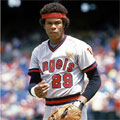 first one to be chosen in his country and the third one in Latin America to enter the Hall of Fame in Cooperstown . But long before that date, in 1967, he had been nominated as the Novice of the Year in the American League and a decade afterwards, as the American League's Most Valuable Player.
first one to be chosen in his country and the third one in Latin America to enter the Hall of Fame in Cooperstown . But long before that date, in 1967, he had been nominated as the Novice of the Year in the American League and a decade afterwards, as the American League's Most Valuable Player.
He was a powerful batter with an average of over .300 during 15 consecutive seasons and secured seven batting leaderships in the American League itself. He was by right in the select list including Ty Cobb, Cap Anson, Honus Wagner, Stan Musial and Ted Williams.
He is remembered by many for his ability to steal bases where he excelled in home stealing, a deed that he successfully achieved on 17 occasions during his entire career. He particularly shone when he made it effective on 7 attempts in 1969.
Likewise, it is fair to note that he also became the best bunt player of his time, but he was never good at playing defensively. That is why, late in his career he was moved from intermediate to first base.
He was chosen 18 times to play in All-Star Games. His best year was in 1977 when he achieved nearly .400 scores and finished the season with a remarkable .388, the highest average since Ted Williams achieved exactly the same record in 1950.
At the end of the nineteen seventies, he joined the California team, where he played for another seven seasons. While he defended the colours of that team, he had the privilege of completing his unbeatable number 3 000, which was enough reason for him to end shortly after an excellent baseball career that had begun when he was only 16 years old. He was an active baseball player for 19 seasons in the rightly called Big Show.
IRVING SALADINO
He was born in Colón on January 23 rd , 1983. This long jumper is amongst the world's best. It could be said that 2006 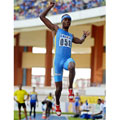 was the year when he established himself as an athlete and leapt to join the elite. This was reinforced by a silver medal he won in the indoor World Championship held during the first two weeks in March of that year, where he marked 8.29 meters during his last attempt.
was the year when he established himself as an athlete and leapt to join the elite. This was reinforced by a silver medal he won in the indoor World Championship held during the first two weeks in March of that year, where he marked 8.29 meters during his last attempt.
Trained by Delyo Moura, this willowy young man who has stopped being a promise to become a reality suddenly achieved other high results placing him amongst the world's best.
It should be noted that during the 2006 Rio Athletics Grand Prix, he achieved one of the best marks of the season and pulled the South American record to pieces with an 8.56 m register. A few days later, he showed his ability one more time in top sports events such as Fortaleza and Belem Grand Prix, where he coincidentally dominated with consecutive 8.47 m jumps.
On the grounds of his sports achievements, he received a well-deserved recognition when he was designated as Sports Ambassador of the Republic of Panama , as per Executive Resolution No. 8 of 23 rd May 2006, a document signed by Martín Torrijos Espino, President of the country. The official certificate was presented by Ramón Cardoze, Director of the National Sports Institute.
In attendance at the ceremony were: Ricardo Saso, Chairman of the Athletics Federation; Aníbal Reluz, Technical Director for Sports; David Saladino, Irving 's father; Cristina de Saladino, Irving 's mother and the outstanding Brazilian specialist Nelyo Moura, his coach.
“I have no words to express my gratitude for this. I am an athlete who wishes to give a lot to his country and I appreciate this gesture. I never thought I would be given so much and I wish to thank the people of Panama ”.
This Colón-born athlete was far from guessing that he would participate in Olympic Games, as he did in Athens 2004 and at the age of 21 he presented credentials, but did not manage to be amongst the first 20 “kangaroos”.
With his subsequent achievements, he managed to erase from the lists one of the world's oldest national records, which dates back to March 2 nd , 1946, that is, sixty years ago!
This record holder was sprinter Lloyd La Beach, the hero of Panama ' sports, with a 7.42 m mark, who had been an Olympic bronze medallist twice in 100 and 200 meters , at the games held in London in 1948.
With his results in the giant South American country, where he trains on a daily basis, Irving became the record owner in that region with an 8.56 m jump.
In addition, he won the gold medal at the Latin American Games held in San Juan , Puerto Rico , where he made an 8.42 m jump.
Panamanian athlete Irving Saladino is fully aware that discipline in his training together with a healthy diet, are the key to his success at international competitions.
Athletics, and particularly long jump, have in this Panamanian sportsman a valuable athlete that is just beginning to win victories. His achievements will be higher in the future and he is, consequently, destined to improve to undreamed marks his respectable results that quickly placed him second in the constantly changeable world ranking.